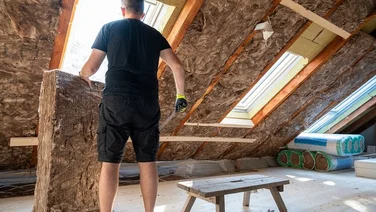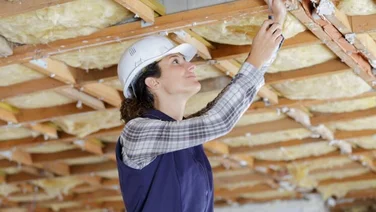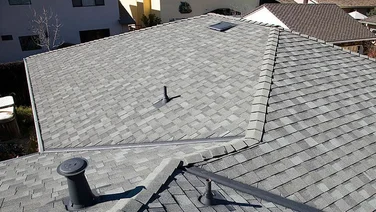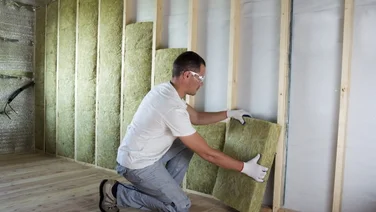- Is spray foam insulation any good?
- Pros of spray foam insulation
- Cons of spray foam insulation
- How much does spray foam insulation cost?
- Can you install spray foam yourself?
- Are all properties suitable for spray foam insulation?
- Can spray foam insulation reduce my property’s value?
- What are the other drawbacks of spray foam insulation?
- What are the alternatives to spray foam insulation?
- Summary
- Spray foam is a method you can use to insulate your home
- It has higher insulation properties than standard fibreglass insulation
- If installed incorrectly, spray foam insulation can cause damaging condensation
- It can affect the value of your property and can make it harder to sell it or get a mortgage
Spray foam insulation, also known as spray polyurethane foam (SPF) is an effective way to insulate your home. But it’s important to be aware that it has drawbacks and can even damage your home.
What’s more, spray foam insulation can cause problems with getting your home mortgaged or with selling it. If the spray foam needs to be removed, removing it could damage your roof.
Therefore, is spray foam insulation actually worth it? It can be, because of its high insulation properties, but you might want to consider options with less risk, such as fibreglass insulation. Spray foam insulation costs more than many other choices too.
If you’re ready to start finding insulation quotes, why not fill in our simple insulation form now? Once you’ve entered in a few details, we’ll put you in touch with our trusted suppliers and they’ll get back to you with free quotes.
Get free spray foam insulation quotes
Answer a few quick questions, and our trusted installers will send you bespoke spray foam insulation quotes – for free.

Is spray foam insulation any good?
Spray foam insulation is an effective way to insulate your home, with higher insulating properties than fibreglass and organic insulation.
There are significant problems with spray foam insulation, however, such as potentially making your home harder to remortgage and sell.
It can save you money on energy bills, and the high energy prices recent years have led more people to consider spray foam insulation for this reason.
In an uninsulated home, around 35-40% of heat is lost through walls and roofs, meaning that if you spend £100 on your heating each month, £35-£40 of that is being wasted. Even if you have ordinary insulation, your home will still be leaking more warmth than it would with spray foam insulation.
Spray foam insulation can save you £540 per year on energy bills – although this figure can vary a lot depending on how much energy you use, which areas you insulate and which type of spray foam you go for. Depending on how much you spend (we’ve covered the costs below), you’re probably looking at five to nine years to break even. But the potential reduction in value of your home is an additional factor to consider seriously.
Whether spray foam insulation is suitable for your needs depends on a number of factors, including your budget, the type of property you have, and whether you’re looking to sell your home (more on that further down the page).
Pros of spray foam insulation
- It can reduce your energy bills – more than 50% of a home’s heat is lost through roofs, walls, and other air leakage points, causing your heating system to work harder and thus costing you more money.
- It’s flexible enough to insulate areas that’d be more difficult or impossible to otherwise.
- It can last for up to 80 years.
- It can help keep rodents and other pests out of your home. It can discourage bats too, but if you have an existing colony in your home you will need to get a specialist to remove it before using spray foam insulation.
- It naturally restricts outside noise, so you’ll get better sound reduction for your property.
Cons of spray foam insulation
- Spray foam insulation can make remortgaging your home difficult – although the Energy Saving Trust says that there should now be less of an issue getting a mortgage if the foam has been installed properly.
- Installing spray foam insulation releases harmful fumes, meaning you’ll need to vacate your home for at least 24 hours.
- It can hinder ventilation, increasing the chance of condensation and damp – if you have a timber roof, you potentially run the risk of it decaying.
- It is usually not suitable for listed buildings, or for those with thatched roofs.
- It usually costs two to three times more than ordinary fabric or fibreglass insulation.
- In some situations, spray foam insulation can reduce the value of your home.
- Installing spray foam insulation is not a DIY job – you’ll almost certainly need a professional to do it.

How much does spray foam insulation cost?
Spray foam insulation costs around two to three times more than alternatives such as fibreglass insulation. We won’t go into all the details here – you can find out more on the exact costs involved in our guide on spray foam insulation costs.
There are two types – open-cell and closed-cell. Closed cell is denser and more rigid. It insulates better but is less breathable.
Costs will depend on the size of your home, the type of insulation and where you are in the UK. On average, you’re looking at £2,500 to £4,075 for a three-bedroom, semi-detached property.
Compare this to using fibreglass to insulate a similarly sized property – between £750 and £1,000 – and the price jump becomes obvious.
If you are eligible, you may be able to get a government grant insulating your home, which could cover some or all of the costs.
Can you install spray foam yourself?
It is definitely better NOT to install spray foam yourself. While getting a professional to install your spray foam insulation might be more expensive, it’s really not a good idea to install spray foam yourself. If applied incorrectly, spray foam insulation can cause serious damage to your roof. The harmful fumes produced during installation are another reason to leave it to a professional.
Are all properties suitable for spray foam insulation?
The majority of properties in the UK can have spray foam insulation, but even if they can have it installed, it’s important to recognise potential challenges. For example, installing spray foam insulation can change how the original roof was designed to perform.
Most pitched roofs were designed to be ‘cold roofs’, where insulation laid above habitable rooms traps the heat below and lets the loft go cold. Spray foam insulation instead traps heat in the loft, turning it into a ‘hot roof’ which could introduce ventilation problems.
If you live in an historic or listed building, spray foam insulation is generally seen as a bad idea. The risks of damaging the building are often too high, despite the heat-saving benefits.
Studies have shown spray foam insulation can cause excess moisture buildup, which isn’t great for old timber roofs. Also, there’s the aesthetic impact to think about. It could affect a building’s character, and you may not be able to get listed buildings consent to do the work.
Eventually, spray foam will lose its effectiveness (albeit after 80+ years), and removing it from old properties could cause damage, especially if they have timber structures.
Can spray foam insulation reduce my property’s value?
Unfortunately, yes, as spray foam insulation continues to attract concerns around excess condensation, which can reduce the value of a property.
The Royal Institute of Chartered Surveyors says that if a property is found to have spray foam insulation, they may either reduce its value, or request an independent specialist report.
A report from the BBC in November 2024 said that as much as a quarter of lenders were refusing mortgage applications because the property had spray foam insulation.
Every installation will be unique and will need assessing on a case-by-case basis. If you plan to sell your property and are thinking about getting spray foam insulation, it is worth investigating whether it will impact the sale.
What are the other drawbacks of spray foam insulation?
One of the big criticisms of spray foam insulation is that while it does reduce energy usage, which helps the environment, the required materials aren’t ‘green’. As a petroleum-based product, spray foam insulation isn’t sustainable.
There are various health risks associated with spray foam insulation. These include:
- Asthma
- Sensitisation
- Lung damage
- Other respiratory and breathing problems
These health issues are mainly a concern during application, and for around 24 hours afterwards – as well as later on if building works or renovations disturb the foam
What are the alternatives to spray foam insulation?
Because of the drawbacks of spray foam insulation, you might want to consider alternatives. One more environmentally-friendly option is cellulose insulation, which is made from recycled paper and other plant-based fibres.
This option has a lower R-value than spray foam insulation, meaning it doesn’t insulate quite as well, but it is around two or three times cheaper and comes from naturally occurring materials.
Many people still rely on the classic fibreglass insulation, which is a tried-and-tested way of keeping your home warm. It isn’t quite as effective as spray foam insulation, but it is cheaper. Another advantage is that you can install it yourself – but if you’re not sure, we’d still recommend getting a professional to do the job.
Summary
- Spray foam insulation is an effective insulation method, with some major drawbacks
- It can make your home more difficult to remortgage or sell
- It’s not environmentally friendly and can present health risks
- Spray foam insulation can last for decades
- It can be the easiest option for hard-to-reach areas







